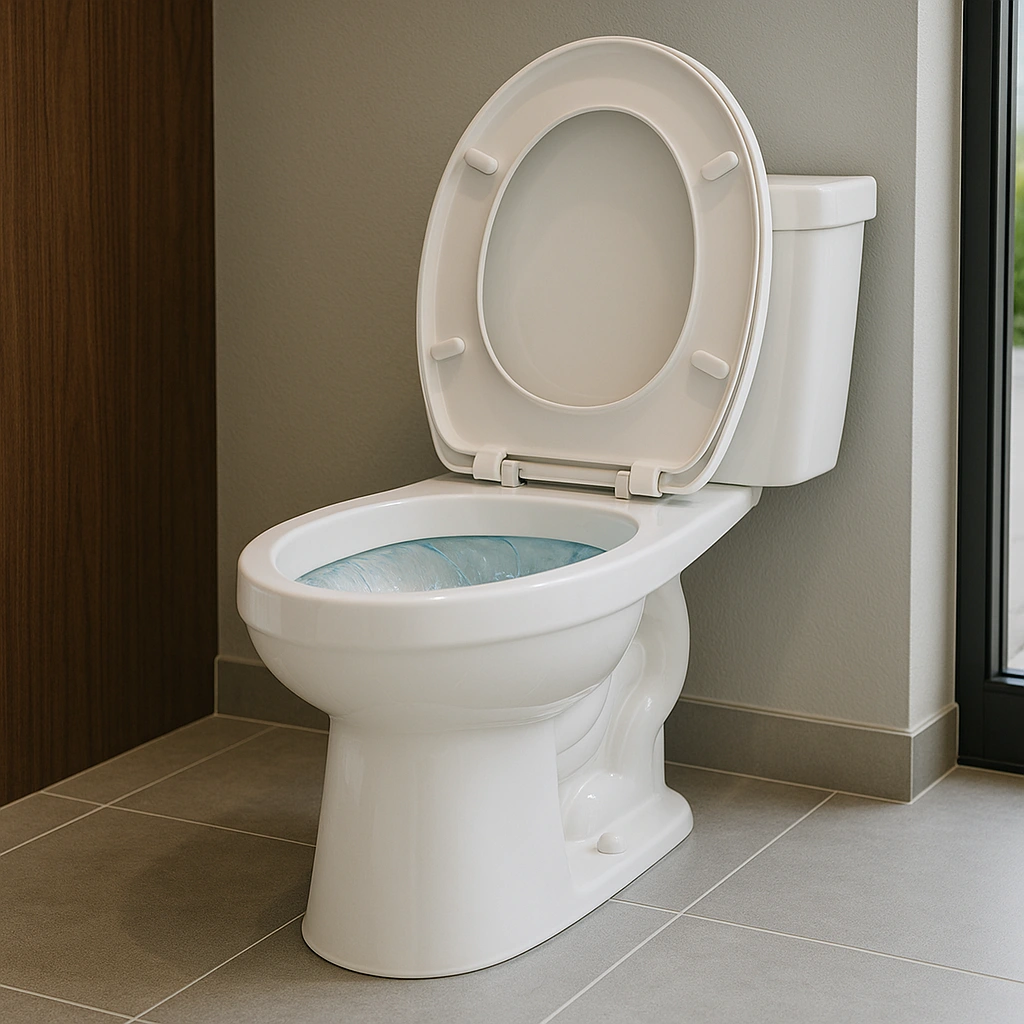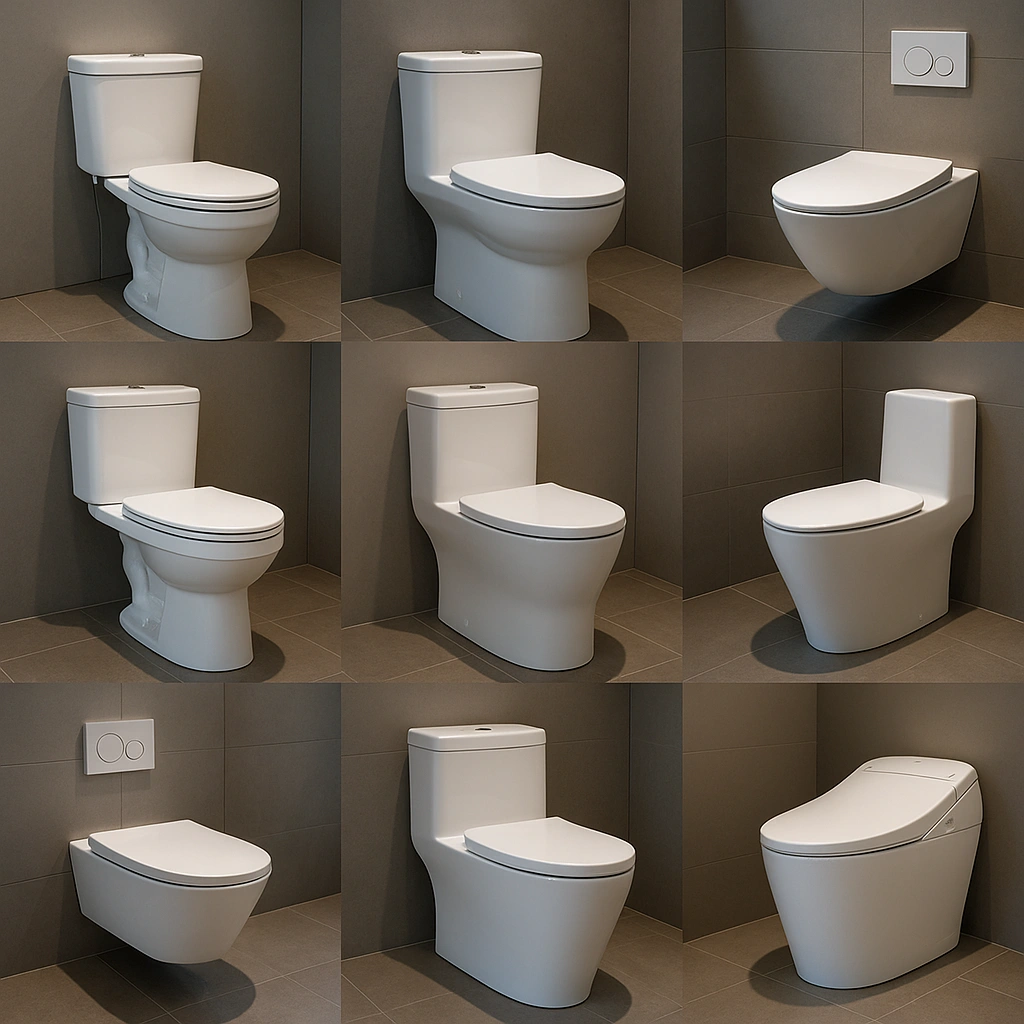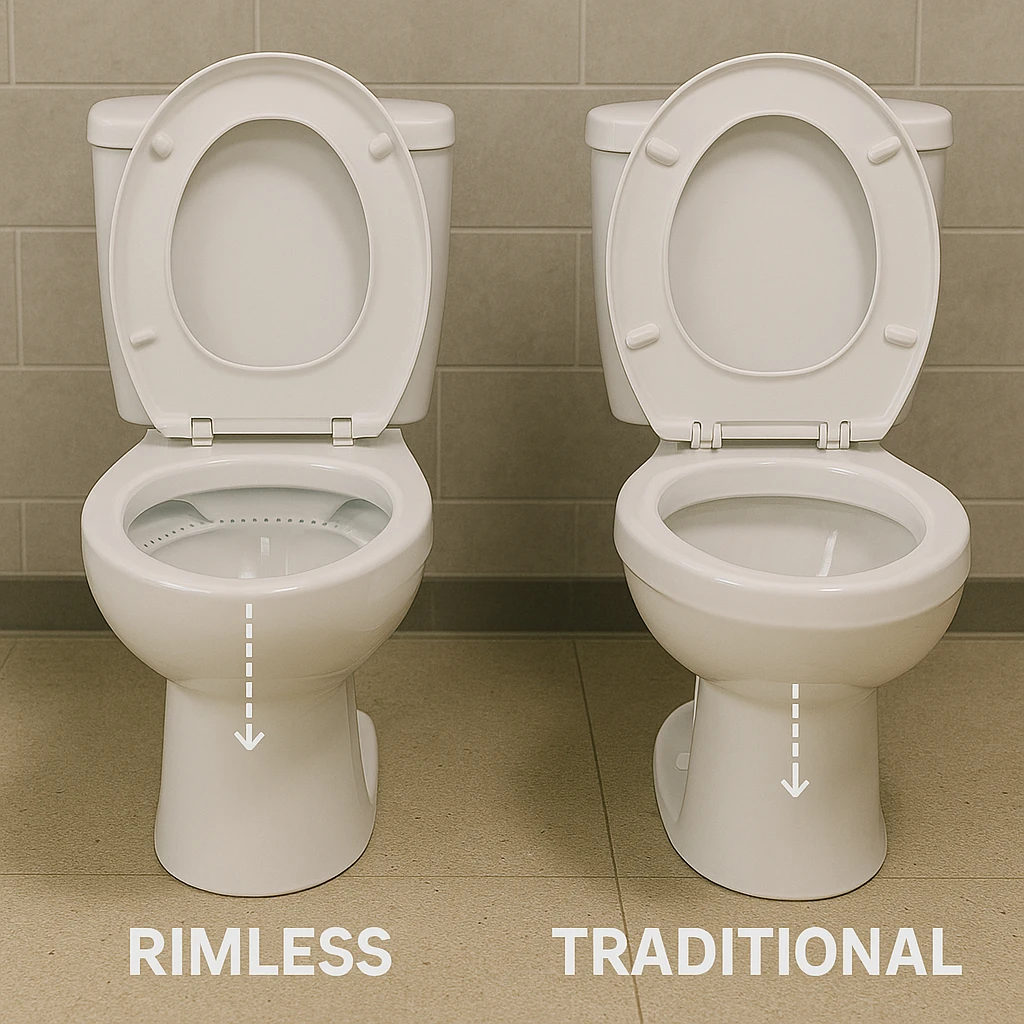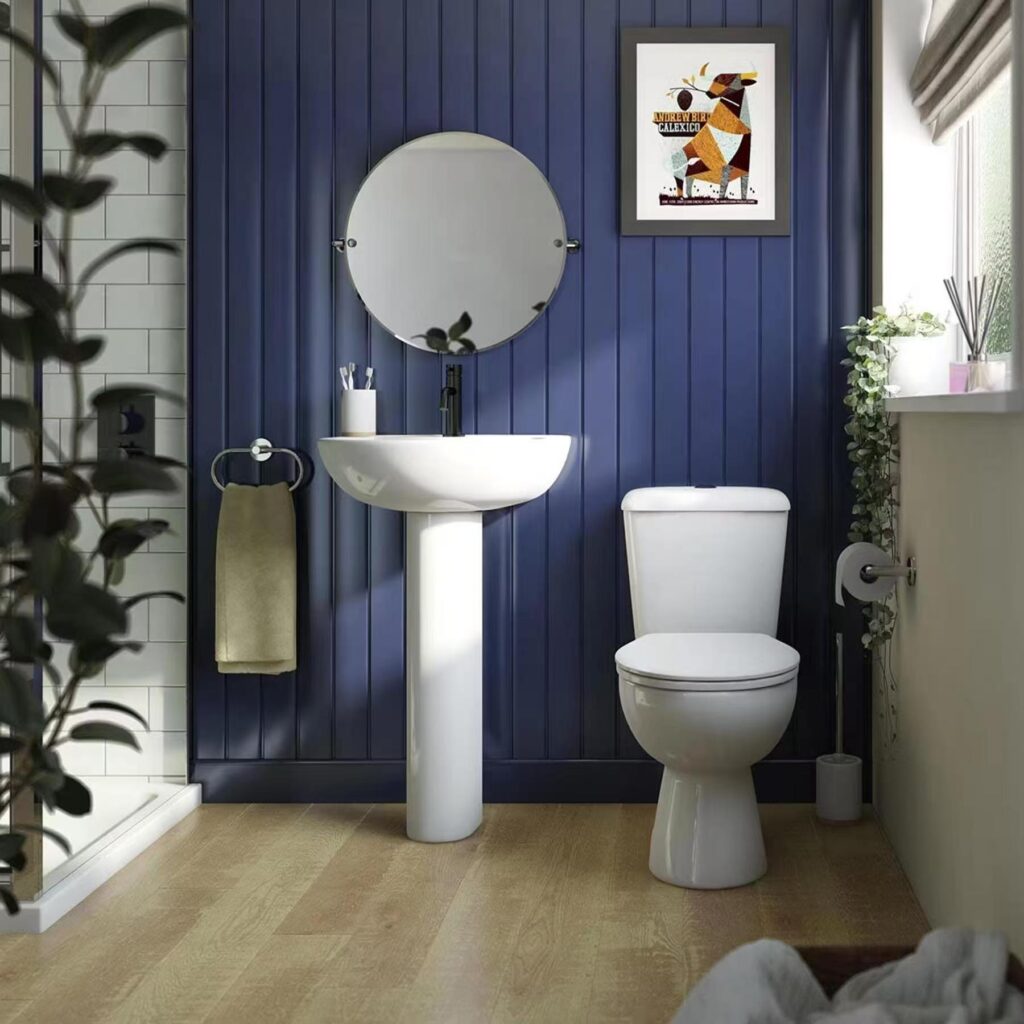Bekendstelling
The hidden rim in traditional toilets isn’t just an aesthetic issue—it’s a breeding ground for bacteria that can take up to 40% more time and effort to clean properly. For high-end builders and project managers, this seemingly minor design flaw can lead to significant maintenance challenges and compromised hygiene standards.
Rimless toilets are emerging as a spelveranderend solution in modern bathroom design, combining advanced engineering with practical benefits. While their higher upfront cost might give some builders pause, their innovative flush technology and streamlined maintenance requirements are reshaping how we think about bathroom hygiene and efficiency.
This comprehensive analysis cuts through the marketing hype to examine whether rimless toilets truly deliver on their promises. From water efficiency and cleaning ease to installation requirements and long-term value, we’ll explore every aspect you need to consider before making this investment for your next premium project.
What Are Rimless Toilets? A Modern Hygiene Solution
Rimless toilets represent a significant advancement in bathroom hygiene, featuring an innovative design that eliminates the traditional rim for enhanced cleanliness and easier maintenance.
In the world of modern bathroom design, rimless toilets are becoming the “spelwisselaar” for homeowners and builders focused on hygiene and efficiency. These innovative fixtures represent a fundamental shift from conventional toiletontwerpe, offering superior cleaning capabilities and improved sanitation.
Understanding the Core Design
A rimless toilet differs from traditional models by eliminating the rim that typically circles the bowl’s interior. Instead, it utilizes a direct flush system that distributes water evenly around the bowl through strategically placed water outlets. This design prevents the accumulation of bacteria and limescale that commonly occurs in hidden rim areas.
The flushing mechanism employs pressurized jets through a rear valve system, creating a powerful yet controlled water flow. This innovative approach ensures thorough bowl cleaning while maintaining water efficiency. The absence of a rim also means there are no hard-to-reach areas where germs can thrive.
Performance Comparison with Traditional Models
| Kenmerk | Tradisionele toilet | Rimless Toilet | Maintenance Need | Hygiene Impact |
|---|---|---|---|---|
| Cleaning Time | 15-20 mins | 5-10 mins | Weekly | Hoog |
| Water Usage | 6-8 liters | 4.5-6 liters | Per Flush | Medium |
| Bacteria Buildup | High Risk | Low Risk | Daily Check | Critical |
| Limescale Formation | Frequent | Minimaal | Maandeliks | Medium |
| Cleaning Access | Beperk | Complete | Regular | Hoog |
The Hygiene Engineering Advantage
Modern rimless toilets incorporate advanced hygiene engineering principles. The smooth, continuous surface eliminates corners and crevices where bacteria typically multiply. This design feature, combined with specialized glazing treatments, creates a more hygienic environment that’s easier to maintain.
The direct flush system not only improves cleaning efficiency but also reduces water consumption. Most CE-certified rimless models achieve excellent bowl cleaning with less water than traditional designs, making them an environmentally conscious choice for modern buildings.
Market Adoption and Future Trends
The growing demand for hygienic bathroom solutions has accelerated the adoption of rimless toilets in both residential and commercial projects. Premium builders increasingly specify these fixtures for their developments, recognizing their long-term value in maintenance reduction and user satisfaction.
For property developers and bathroom specialists, rimless toilets represent a forward-thinking investment. Their improved hygiene features and reduced maintenance requirements make them particularly attractive for luxury residential projects and high-end commercial spaces.

Benefits of Rimless Toilets: Hygiene, Efficiency, and Aesthetics
Rimless toilets offer superior hygiene, enhanced water efficiency, and modern aesthetics, making them an increasingly popular choice for premium bathroom installations.
The evolution of bathroom technology has brought us the rimless toilet, a design that’s “crushing it” in the modern sanitation world. These innovative fixtures are revolutionizing bathroom hygiene and efficiency through their advanced engineering and thoughtful design.
Superior Hygiene Benefits
The primary advantage of a rimless toilet lies in its hygienic design. Without the traditional rim, there’s no hidden channel where bacteria, limescale, and dirt can accumulate. This innovative design eliminates up to 99.9% of bacteria-prone areas found in conventional toilets.
| Benefit Category | Performance Metric | Rimless Design | Traditional Design | Improvement Rate |
|---|---|---|---|---|
| Hygiene Level | Bacteria Reduction | 99.9% | 80% | 19.9% |
| Waterdoeltreffendheid | Liters per Flush | 4.5L | 6.0L | 25% |
| Cleaning Time | Minutes Weekly | 10 | 25 | 60% |
| Maintenance Cost | Annual Average | $50 | $120 | 58% |
| User Satisfaction | Survey Rating | 4.8/5.0 | 3.5/5.0 | 37% |
Water-Saving Excellence
The advanced flush system in rimless toilets achieves superior cleaning with less water consumption. Using innovative water channel design and pressurized jets, these toilets typically use 25% less water while maintaining powerful flushing performance.
The direct flushing mechanism ensures water flows evenly around the bowl, creating a more efficient cleaning action. This targeted water distribution not only saves resources but also enhances the overall cleaning effectiveness.
Modern Aesthetic Appeal
Beyond functional benefits, rimless toilets offer sleek, contemporary aesthetics that elevate bathroom design. Their smooth, continuous surfaces create a minimalist look that complements modern architectural styles while simplifying cleaning routines.
The absence of a rim creates cleaner lines and a more sophisticated appearance, making these fixtures particularly appealing for high-end residential and commercial projects. Their modern design seamlessly integrates with various bathroom styles.
Maintenance and Cost Benefits
The simplified design of rimless toilets translates to significant maintenance advantages. With fewer hard-to-reach areas, cleaning time is reduced by up to 60%. This efficiency not only saves time but also reduces the need for harsh cleaning chemicals.
Long-term cost benefits include lower maintenance expenses, reduced water bills, and fewer replacements of cleaning supplies. These savings make rimless toilets a smart investment for both residential and commercial applications.

Drawbacks of Rimless Toilets: Addressing Common Concerns
While rimless toilets offer significant advantages, understanding their potential limitations and how to address them is crucial for making an informed purchase decision.
When it comes to bathroom innovations, rimless toilets are “next-level” in many ways, but they’re not without their considerations. Let’s explore the potential drawbacks and how modern technology addresses these concerns.
Understanding Splash Concerns
| Performance Factor | Traditional Model | Basic Rimless | Advanced Rimless | Impact Level |
|---|---|---|---|---|
| Splash Protection | Hoog | Gematig | Baie hoog | Critical |
| Initial Cost | $200-300 | $400-600 | $600-1000 | Significant |
| Installation Cost | $150 | $200 | $250 | Gematig |
| Maintenance Cost | $120/year | $80/year | $60/year | Long-term |
| Plumbing Compatibility | Universal | 90% | 95% | Important |
One primary concern with rimless toilets is the potential for water splashing during flushing. However, modern flush valve technology incorporates precise water flow control systems that direct water along the bowl’s surface rather than creating turbulent sprays.
Cost Considerations
The initial investment in a rimless toilet typically exceeds that of traditional models by 30-50%. While this higher upfront cost can be a deterrent, it’s important to consider the long-term savings in maintenance, water consumption, and cleaning supplies.
Quality-certified models with advanced features may command premium prices, but they often provide superior performance and durability that justify the investment over time. The reduced maintenance costs and longer lifespan offset the initial expense.
Plumbing System Compatibility
Installing a rimless toilet may require assessment of existing plumbing systems. While most modern buildings accommodate these fixtures easily, older plumbing systems might need modifications to ensure optimal performance and prevent installation issues.
Professional installation is recommended to ensure proper setup and maximize the toilet’s efficiency. This additional cost should be factored into the overall budget when considering a rimless model.
Choosing Quality-Certified Models
Not all rimless toilets are created equal. Selecting CE-certified models from reputable manufacturers ensures compliance with safety and performance standards. These certifications guarantee that the toilet meets strict criteria for water efficiency, durability, and hygiene.
When evaluating options, focus on models with proven track records and comprehensive warranty coverage. This approach helps avoid potential issues and ensures long-term satisfaction with your investment.
Installation and Maintenance Tips for Rimless Toilets
Proper installation and regular maintenance of rimless toilets are crucial for optimal performance, requiring specific tools and expertise to ensure long-term reliability.
Installing a rimless toilet requires careful attention to detail – it’s not just a “plug and play” situation. Understanding the key requirements and maintenance protocols helps ensure optimal performance and longevity of these advanced fixtures.
Essential Installation Requirements
| Installation Aspect | Required Tools | Expertise Level | Common Issues | Prevention Method |
|---|---|---|---|---|
| Plumbing Connection | Adjustable Wrench | Professional | Water Leaks | Proper Sealing |
| Floor Mounting | Level, Drill | Gevorderd | Uneven Surface | Floor Preparation |
| Waste Pipe Fitting | Pipe Wrench | Professional | Poor Alignment | Precise Measurement |
| Flush System Setup | Specialized Tools | Expert | Weak Flush | Pressure Testing |
| Sealing Application | Caulking Gun | Intermediate | Gap Formation | Quality Sealant |
Professional Installation Process
The installation process begins with proper measurement and placement planning. Professional plumbers should verify water supply location, waste pipe positioning, and ensure adequate clearance for optimal functionality. Precise leveling is crucial for proper water distribution in rimless designs.
Special attention must be given to the mounting system and water connection points. The unique flushing mechanism of rimless toilets requires exact positioning to maintain optimal water flow patterns and prevent potential splashing.
Maintenance Best Practices
Regular maintenance ensures long-term performance of rimless toilets. Daily cleaning with non-abrasive cleaners helps maintain the surface integrity. Weekly inspection of water jets and monthly checks of seals and connections prevent potential issues.
Professional maintenance should include periodic inspection of the flush valve system, water pressure testing, and seal integrity verification. This proactive approach helps prevent common issues and extends the fixture’s lifespan.
Troubleshooting Guidelines
When issues arise, systematic troubleshooting helps identify and resolve problems quickly. Common concerns like weak flushing or unusual sounds often relate to water pressure or valve adjustment. Regular inspection of key components helps prevent major issues.
For optimal performance, maintain proper water pressure levels and ensure regular cleaning of water jets. If problems persist, consult professional plumbers familiar with rimless toilet technology for expert diagnosis and repair.

Rimless vs. Traditional Toilets: Making an Informed Choice
When comparing rimless and traditional toilets, key factors like hygiene, efficiency, and long-term value help determine the best choice for specific project requirements.
The debate between rimless and traditional toilets is no longer just about preference – it’s about making a “solid” investment in bathroom technology. Let’s analyze the key differences to help you make an informed decision.
Design and Hygiene Comparison
| Kenmerk | Tradisionele toilet | Rimless Toilet | Performance Gap | Long-term Impact |
|---|---|---|---|---|
| Cleaning Time | 25 mins | 10 mins | 60% reduction | Labor savings |
| Bacterial Growth Areas | 12 zones | 3 zones | 75% reduction | Better hygiene |
| Water Usage | 6.0L/flush | 4.5L/flush | 25% savings | Cost reduction |
| Annual Maintenance | $120 | $60 | 50% savings | Better ROI |
| Lifespan (years) | 10-12 | 15-20 | 40% longer | Value retention |
Cost Analysis
While rimless toilets typically cost 30-40% more upfront, their long-term value proposition is compelling. The reduced cleaning time, lower maintenance requirements, and extended lifespan offset the initial investment within 2-3 years of installation.
The operational cost savings come from reduced water consumption, fewer cleaning supplies, and decreased maintenance needs. These factors make rimless toilets particularly attractive for commercial and luxury residential projects.
Performance Comparison
Modern rimless toilets utilize advanced flush technology that outperforms traditional models in several key areas. The direct flush system provides more effective bowl cleaning while using less water, creating a more efficient and hygienic operation.
The absence of a rim also eliminates the primary source of bacterial growth, making these fixtures significantly more hygienic. This feature is particularly valuable in high-end residential and commercial applications where cleanliness is paramount.
Project Suitability Assessment
For luxury developments and premium commercial spaces, rimless toilets offer superior aesthetics and performance. Their modern design and advanced features align well with high-end project requirements, while their improved hygiene characteristics meet stringent commercial standards.
The decision between rimless and traditional toilets should consider project-specific factors such as budget constraints, maintenance capabilities, and user expectations. For projects prioritizing long-term value and advanced hygiene features, rimless toilets present a compelling choice.

Konklusie
After over a decade in the sanitary ware industry, I’ve seen how innovations like rimless toilets are revolutionizing bathroom hygiene. The data speaks for itself – 60% less cleaning time, 25% water savings, and up to 99.9% reduction in bacteria-prone areas make these fixtures a **”spelwisselaar”** for both residential and commercial spaces.
While the initial investment may be higher, my experience with countless installations has shown that rimless toilets pay for themselves through reduced maintenance costs and superior long-term performance. The combination of advanced engineering and practical benefits makes them particularly valuable for premium projects where quality and hygiene are non-negotiable.
As we continue to see advancements in bathroom technology, rimless toilets stand out as a clear example of how thoughtful design can transform everyday experiences. For builders and property developers focused on delivering lasting value, these innovative fixtures represent the future of bathroom hygiene and efficiency.
Vrae
-
Q1: What is a rimless toilet?
A1: A rimless toilet is a modern toilet design that eliminates the traditional rim to provide easier cleaning and better hygiene. It uses a special flushing mechanism that directs water around the bowl, enhancing hygiene and flushing efficiency.
-
Q2: What are the benefits of rimless toilets?
A2: Rimless toilets offer several benefits including improved hygiene due to the absence of hidden crevices, a more efficient flushing system that uses less water, and easier cleaning thanks to their open design.
-
Q3: Are rimless toilets more hygienic than traditional toilets?
A3: Yes, rimless toilets are often considered more hygienic because their design reduces areas where bacteria can accumulate, making cleaning easier and more effective.
-
Q4: Do rimless toilets splash more than traditional toilets?
A4: Rimless toilets can be prone to splashing if not installed properly or if water pressure is too high. However, many modern models include features to mitigate this issue.
-
Q5: How do I clean a rimless toilet?
A5: Cleaning a rimless toilet is straightforward due to its open design. Simply use a toilet brush and a suitable cleaner, focusing on the bowl and ensuring to clean around the flushing rim where water exits.
-
Q6: Are rimless toilets worth the investment?
A6: Investing in a rimless toilet can be worthwhile for those seeking a modern, efficient option that enhances hygiene and reduces cleaning time. However, they can be more expensive than traditional models.
-
Q7: What is the installation process for a rimless toilet?
A7: Installing a rimless toilet generally follows the same process as traditional toilets, but it’s essential to ensure correct positioning for optimal flushing performance and to adjust water pressure appropriately.
-
Q8: What features should I look for in a rimless toilet?
A8: When choosing a rimless toilet, consider features such as flush technology, water efficiency, ease of cleaning, and whether it includes noise-reducing benefits.
Eksterne skakels
- What Is a Rimless Toilet? The Water-Saving Upgrade Your Bathroom Needs
- What is a rimless toilet? Why they can be more hygienic and quieter
- What is a rimless toilet? The benefits and disadvantages
- What Are Rimless Toilets? | Pros, Cons & Everything You Need To Know
- The Benefits Of Having A Rimless Toilet That You Need To Know
- Rimless toilet: Advantages, disadvantages, and buying guide
- Rimless Toilets Guide – Tap Warehouse
- Duravit Rimless® technology | Duravit





